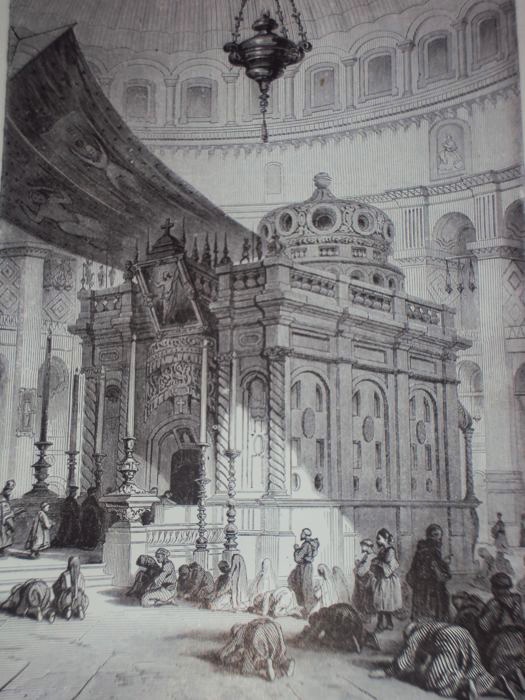François-René de Chateaubriand
1768 - 1848
“A man meditates on the ruins of Rome”
Portrait of Chateaubriand by Anne-Louis Girodet De Roussy-Trioson, 1810 (Saint-Malo Museum)
François-René, Viscount of Chateaubriand, born in Saint-Malo on September 4, 1768, and died in Paris on July 4, 1848, was a French writer and politician. He is considered the father of French Romanticism and one of the great figures of French literature.
Childhood at Combourg
It was at St Malo, during a stormy night in September 1768, that François-René’s mother ‘inflicted life on me’. During a childhood divided between the chateau of Combourg and rather desultory studies at Dol, Rennes and Dinan, he gave himself up to idleness and solitude.
In François-René’s portrait of his father who regulated everyone’s behaviour and imposed his moods on the chateau, one can sense the fear and respect which this taciturn man inspired in his son.
In this austere and isolated life, only his sister Lucile offered François-René shared moments. In her he found an ally, a companion in his solitude. She encouraged him to write, revealing his intuition and taste for poetry. He devotes long passages to her in his Memoirs d’outre-tombe. She inspired two of his heroines: Amélie in René and Velléda in Martyrs .It was also at Combourg that François-René’s first sensations of love were manifest. The trouble and torments as well as the exaltation these provoked are the object of passages in Memoires de l’outre-tombe.
The years at Combourg certainly marked the spirit of Chateaubriand, and the passages in Memoires d’outre-tombe devoted to this place where he passed his early years are suffused with the intense feelings experienced by the author. This emotion was at its height in his farewell to Combourg.
Author and political figure, François-René de Chateaubriand is considered to be the Father of Romanticism in the literary world. ‘Supporter of the Bourbons by honour, monarchist by reason, Republican by taste and character’, he was witness to the end of one world and the beginning of another, living through seven political regimes. His main monumental work, Memoirs from the beyond the Grave, would become a model of prose-poetry for generations of authors.
Born on September 4th 1768 at Saint-Malo, the famous author passed his childhood and adolescence at the chateau of Combourg, together with his elder brother and his sisters. At the age of 18, after studies at Dol, Rennes and Dinan, he enlisted in the regiment of Navarre, before being presented at the Court of Versailles in 1787.
Witness of the fall of the Bastille in January 1789, he condemned the violence of the revolutionary movement and left France to travel in America. On his return to St-Malo in 1792, he married Céleste Buisson de la Vigne, then rejoined the army of the Princes. Wounded at the siege of Thionville, he recuperated in England where he lived in poverty. During this period, his brother and sister-in-law were guillotined in Paris.
His work entitled Essay on ancient and modern Revolutions was published in 1797. Atala, which came out in 1801, was his first literary success.
The political career of Chateaubriand began on his return to France in 1800, under the consulate of Napoleon Bonaparte, who chose him to accompany Cardinal Fesh to Rome as first secretary to the embassy. He represented France at a consular level for the Republic du Valais when he learnt of the execution of the Duc d’Enghein in 1804. He resigned at once and joined the opposition. Devoting his time purely to writing, he went on a voyage in the East and on his return, exiled by Napoleon, bought the Vallée-aux-Loups and set up home there with his wife. It was there that he wrote Les Martyrs which was published in 1809 and began the composition of his Memoirs. In 1811, Itinéraire de Paris à Jerusalem (Journey from Paris to Jerusalem), written from his notes taken during the voyage in the East, was published. The same year the author was elected a member of the Academie Française.
At the time of the Restoration, he returned to the forefront of the political scene with Bonaparte and the Bourbons, a pamphlet against the deposed Emperor, thousands of copies of which were distributed. He then became ambassador to Sweden, but before he could leave Paris, Napoleon escaped from the island of Elba and set about the re-conquest of France. Chateaubriand followed Louis XVIII to Gand, then was named Minister and Pair de France in 1815. After the publication of La Monarchie selon la Charte in 1816, which attacked the order of September 5th (dissolution of the ‘unobtainable chamber’), he was dismissed and passed once more into opposition, among the ultra-royalists. Co-founder of the journal Le Conservateur, he became one of its main contributors. During his two years of collaboration (1818-1820) he showed himself to be a fierce defender of the liberty of the press.
Between 1821 and 1828, he was in turn Minister of France in Berlin, ambassador in London, representative of France at the congress of Verona, Minister of Foreign Affairs and Ambassador to Rome before retiring from political life, as he refused to support the new regime after the fall of Charles X.
In 1826 he signed a contract for the edition of his complete works, and in 1834 he gave his first public lecture about the Memoirs d’outre-tombe at the house of Juliette Récamier. The work was published after his death, first as a serial in The Press, then in book form (1849-1850). François-René de Chateaubriand died in Paris on July 4th 1848 when he was almost 80 years old.
Influences
His influences were the sea, the forest of Brocéliande enchanted by Merlin, the chateau of Combourg inhabited by silence and surrounded by ghosts. Idleness and solitude inspired his dreams and doubts. He had an unassuming mother and a young sweet, loving sister for company, a stern, authoritarian father for a model: ‘Conduct yourself like a gentleman and never dishonour your name’. This is the context which made Chateaubriand what he was.
In politics he was faithful to his ideas to the point of returning to the opposition through conviction on several occasions. As a journalist he was an involved and passionate defender of the liberty of the press in turbulent times, co-founding a journal (The Conservateur). He was also a visionary, who accurately depicted the evolution of 19th and 20th century society.
But he was above all a man who forged a prime place in the history of literature, as a precursor and model for the Romantic movement. Victor Hugo, who ‘who wanted to be Chateaubriand or nothing”, paid homage to him in the poem La canadienne. Gustave Flaubert, Paul Morand, Edgar Morin, Michel Tournier and Michel Butor are among the many authors marked and influenced in their own work by the writings of Chateaubriand.
Through his descriptions of American landscapes, the famous author gave a taste for travelling to many generations. But above all he transmitted a powerful story, giving another dimension to the accounts of explorers, missionaries and voyageurs of the 17th to 19th centuries, creating a bridge with future generations.
Grand Bé - Grave of Chateaubriand - Saint Malo
His remains are transported to Saint-Malo and deposited facing the sea, according to his wish, on the rock of Grand Bé, an islet in the bay of his hometown, which can be accessed on foot from Saint-Malo when the sea has receded.
Translations ©Wendy Mewes














